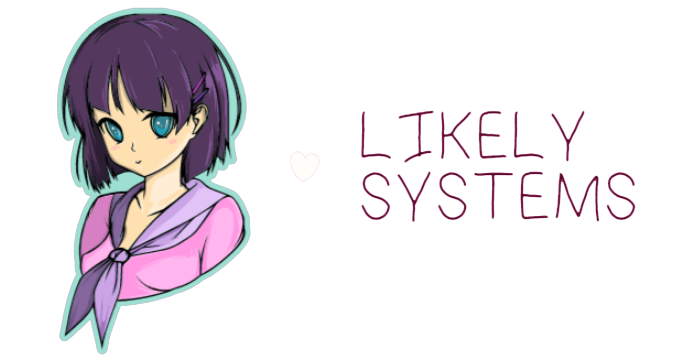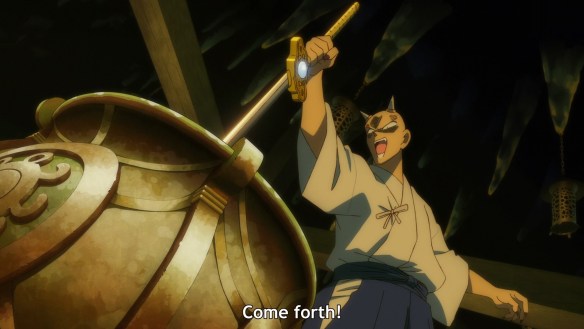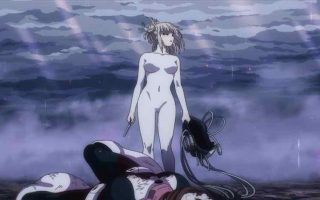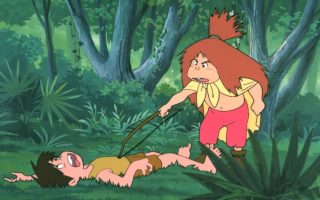Hello folks, and welcome back to Wrong Every Time. Today we’re checking back in on the adventures of a feral swordsman and his reluctant chaperone, as we explore a fresh episode of Gosho Aoyama’s Yaiba: Samurai Legend. When last we left off, Yaiba and Sayaka had taken to the hills, in pursuit of a sword worthy of matching Onimaru’s demonic Fujin. Swiftly encountering its counterpart Raijin’s beetle-shaped protector, Yaiba attempted to tame the demon blade, only to prove incapable of containing its power.
Given that embarrassing defeat, I imagine we’re due for an honest-to-goodness training arc, at least if this fresh adaptation’s breakneck pace will allow for it. That’s fine by me, as frankly, one thing I’m particularly curious about here is how anyone demonstrates they’re stronger, smarter, or better-prepared than their opponent. Yaiba’s battles have so far been kinetic spectacles heavy on flash and trickery, making me assume Aoyama isn’t really a “power systems” kind of guy, but a shonen without some sense of personal martial progression tends to have difficulty sustaining itself. The alternative is basically “perpetual episodic invention” (as demonstrated by early One Piece and Dragon Ball), but as far as that goes, Aoyama also seems focused on a singular, continuing narrative rather than a procession of rambling adventures. Thus we find ourselves at a crossroads, with the fundamental nature of Yaiba’s narrative progression an open question. Let’s find our answer!
Episode 4
We begin with Onimaru summoning a collection of ancient demonic spirits, which implies we’re likely moving into a sort of Sailor Moon-adjacent monster-of-the-week model, with Yaiba being forced to overcome one after another demon in sequence, presumably utilizing some new trick, discovery, or emotional lesson to overcome each hurdle in turn. This model can support a more gamified model of action storytelling (like in Gundam, where victories are often achieved on the back of new technological innovations, creating a strong synergy between storytelling and introductions of new real-world product lines), or it can also be taken in a more purely episodic, character-developing direction (like Sailor Moon, where victory often involves coming to some personal emotional revelation)
Regardless, the sequence shows off this production’s strong smoke effects, as well as its fusion of detail-rich lineart and voluminous space via multiplanar panning
Onimaru says he is reviving eight ogres, but then quickly clarifies “on the way, you will have assistants.” So eight bosses, but with wiggle room to add in particularly pernicious minions if Aoyama chooses. It can be tricky to balance these things; audiences desire some degree of perspective regarding the scope of a narrative, as well as a sense of forward momentum, but weekly shonen manga (particularly in earlier eras) are somewhat defined by their infinite replicability, their ability to just keep going forever if the ratings don’t drop
This can lead to awkward tensions, like Togashi essentially writing his way past the top end of Yu Yu Hakusho’s power structure, and ultimately abandoning an implication of continuous deeper hell layers just so he could coherently finish the damn thing
“If you fail, what little worth you have will disappear.” Onimaru holds these ogres to his own exacting standards. He still needs more definition as a character to act as a meaningful pillar of this narrative
“Attack of the Eight Ogres.” In certain shows, a squad of nefarious villains can basically be the closest thing the audience has to an indication of the narrative’s scale. Unless your narrative is grounded in specific internal objectives (which can range from the efficient simplicity of “collect seven dragon balls” to more complicated goals like “reclaim the kingdom” or whatnot), “we gotta beat all eight of these guys” might be the clearest indicator of progress the audience gets
It’s interesting that Yaiba feels so intentionally constrained in its scale, given Aoyama would then go on to write one of the most endlessly replicable manga in history
Nice gag of timing as Yaiba attempts to walk on a lily pad – a slow, serene buildup into an abrupt splash. Much of comedy in anime comes down to a mastery of timing; if a failed joke isn’t lousy on its face (like shonen’s endless, interminable variations on “loudness is funny”), its failure generally comes down to the speed of delivery
Our training is still concerned with concrete reflections of increased strength and agility; like how Yaiba was previously training on the roof to improve his balance and spatial awareness, he is now seeking to cross these lily pads in order to improve his flow, agility, and lightness of presence
In our modern isekai (or more broadly “litRPG”) era, writers have a tendency to convey physical or magical strength like videogame abilities, sometimes even with actual numbers attached to different powers. I can understand this instinct as a desire to bring concrete tactical interplay to action (or less sympathetically, as a direct consequence of only engaging with these sorts of stories in the first place), but you absolutely do not need to make your story take place in a videogame world in order to impart clear stakes on action drama. Just take a look at the Shaw Brothers catalog, which is all about creating coherent contrasts of power with genuine human abilities
“Cast away hesitation, embrace lightness.” Here, Yaiba’s physical “upgrade” is tethered to an emotional breakthrough, another easy route to justifying such revelations
Meanwhile, Onimaru is… attacking the prime minister!? Not what I was expecting, but I’m all for it – I appreciate when these stories actually seem attached to their own worlds. I just finished Jujutsu Kaisen, and one of my many complaints with that series was how Akutami clearly didn’t make any effort to integrate his fantastical story with his modern backdrop. Not much point in making an urban fantasy if all your stories might as well take place in the DBZ wasteland
Onimaru swiftly declares himself ruler of Japan
On the other side, Yaiba is woven into the continuity of the world in a different way, by being compared to the legendary swordsman Kojiro Sasaki
Ooh, love this layout framed from beneath the lily pads. A neat way to create a sense of the challenge to income, by emphasizing the watery cost of defeat
Back at the treehouse, Sayaka greets a pair of visitors who are presumably our first two ogres
Nice beat of Sayaka not being fazed by this lady saying the tiger “looks tasty,” because that’s frankly also something Yaiba would say
Seems like these specific oni are modeled after a frog and… maybe a dragon? I’m glad they’re diversifying our enemy designs, which will presumably also inform their abilities
Nope, she’s a snake. Their true forms look a lot like Dragon Quest bosses
Oh my god, their “minions” are basically just horn-bearing copies of Aoyama’s “shadowy culprit” design from Case Closed
Musashi describes Yaiba’s technique of “laughing a lot to throw your opponent off balance” as “Shoten,” a crucial martial technique. Luffy puts this technique to consistent effective use in One Piece
Glad to see Sayaka getting some cracks in on these minions as well
Yaiba draws the sword and is once again overcome by the thunder god, prompting Musashi to propose a truce with the oni as they deal with this greater threat. Some nice unexpected twists on convention here, with Yaiba and Onimaru seemingly equally susceptible to the true threat which is the power of these blades
Musashi manages to knock the energy orb out of the blade, restoring Yaiba’s senses
Our frog oni now respects Musashi too much to betray him. Always a fan of likable, recruitable villains
“Lord Onimaru has no time for pathetic sentimental fools!” Again emphasizing how Onimaru and his legion are defined by his spartan, uncompromising philosophy
I like how this snake’s trident echoes a snake’s actual attack pattern, striking at range with multiple sharp points. A natural way to create unique dynamics among the enemies, by echoing their animal theming in their attacks
With the blade now possessing an empty ring in its hilt, Yaiba intuitively comes up with a new attack, spinning the blade to increase its force. Aoyama’s doing a good job of integrating these “upgrades” naturally into the ongoing conflict
“So he was just some ordinary snake.” Even the eight oni are ultimately innocent creatures – it is truly the swords’ influence that is provoking all the conflict here
And Done
Excellent work, Yaiba! Well, apart from the bit where you burned Musashi’s house down, that wasn’t ideal. Nonetheless, our team emerges from their first oni encounter with new powers, an unexpected ally, and a sword that hopefully won’t attempt to take over Yaiba’s body again. This episode did a fine job of clarifying both Yaiba’s thematic intent (an exploration of the corrupting nature of power) and its moment-to-moment tactical drama (grounded battles with evolving field conditions and a focus on martial arts fundamentals), offering us a clear, confident portrait of the hurdles to come. With a stable narrative foundation to support its production flourishes, I’m eager to see what beasty we contend with next!
This article was made possible by reader support. Thank you all for all that you do.




